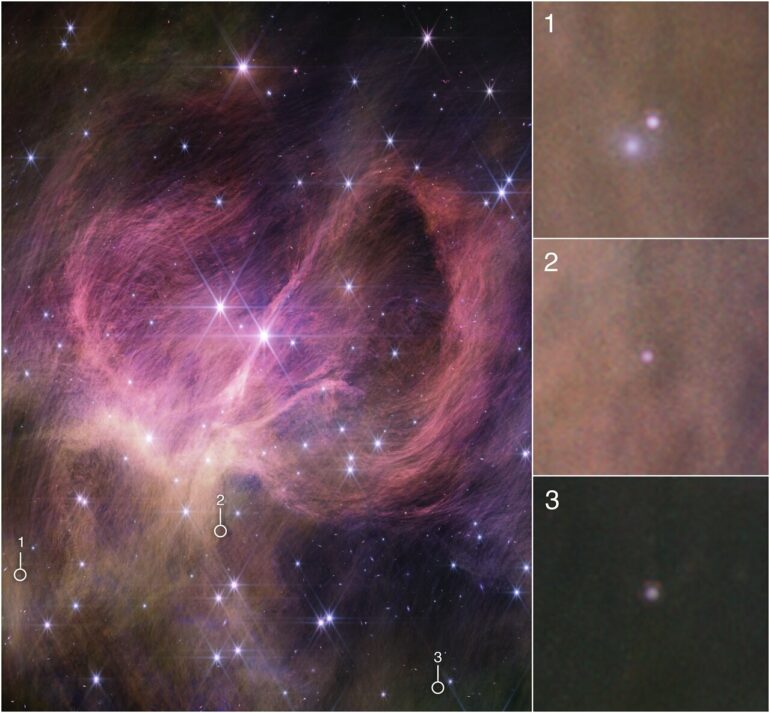Near the outskirts of the Small Magellanic Cloud, a satellite galaxy roughly 200,000 light-years from Earth, lies the young star cluster NGC 602. The local environment of this cluster is a close analog of what existed in the early universe, with very low abundances of elements heavier than hydrogen and helium.
The existence of dark clouds of dense dust and the fact that the cluster is rich in ionized gas also suggest the presence of ongoing star formation processes. Together with its associated HII region N90, which contains clouds of ionized atomic hydrogen, this cluster provides a valuable opportunity to examine star formation scenarios under dramatically different conditions from those in the solar neighborhood.
An international team of astronomers, including Peter Zeidler, Elena Sabbi, Elena Manjavacas and Antonella Nota, used Webb to observe NGC 602 and they detected candidates for the first young brown dwarfs outside our Milky Way. The study is published in The Astrophysical Journal.
“Only with the incredible sensitivity and spatial resolution in the correct wavelength regime is it possible to detect these objects at such great distances,” said lead author Peter Zeidler of AURA/STScI for the European Space Agency.
“This has never been possible before and also will remain impossible from the ground for the foreseeable future.”
Brown dwarfs are the more massive cousins of giant gas planets (typically ranging from roughly 13 to 75 Jupiter masses, and sometimes lower). They are free-floating, meaning that they are not gravitationally bound to a star as exoplanets are. However, some of them share characteristics with exoplanets, like their atmospheric composition and storm patterns.
“Until now, we’ve known of about 3,000 brown dwarfs, but they all live inside our own galaxy,” added team member Elena Manjavacas of AURA/STScI for the European Space Agency.
“This discovery highlights the power of using both Hubble and Webb to study young stellar clusters,” explained team member Antonella Nota, executive director of the International Space Science Institute in Switzerland and the previous Webb Project Scientist for ESA.
“Hubble showed that NGC602 harbors very young low mass stars, but only with Webb we can finally see the extent and the significance of the substellar mass formation in this cluster. Hubble and Webb are an amazingly powerful telescope duo.”
Zeidler stated, “Our results fit very well with the theory that the mass distribution of bodies below the hydrogen burning limit is simply a continuation of the stellar distribution. It seems they form in the same way, they just don’t accrete enough mass to become a fully fledged star.”
The team’s data include a new image from Webb’s Near-InfraRed Camera (NIRCam) of NGC 602, which highlights the cluster stars, the young stellar objects, and the surrounding gas and dust ridges, as well as the gas and dust itself, while also showing the significant contamination by background galaxies and other stars in the Small Magellanic Cloud. These observations were made in April 2023.
“By studying the young metal-poor brown dwarfs newly discovered in NGC602, we are getting closer to unlocking the secrets of how stars and planets formed in the harsh conditions of the early universe,” added team member Elena Sabbi of NSF’s NOIRLab, the University of Arizona, and the Space Telescope Science Institute.
“These are the first substellar objects outside the Milky Way,” added Manjavacas. “We need to be ready for new ground-breaking discoveries in these new objects.”
More information:
Peter Zeidler et al, Discovering Subsolar Metallicity Brown Dwarf Candidates in the Small Magellanic Cloud, The Astrophysical Journal (2024). DOI: 10.3847/1538-4357/ad779e. iopscience.iop.org/article/10. … 847/1538-4357/ad779e
Provided by
European Space Agency
Citation:
Webb finds candidates for first young brown dwarfs outside the Milky Way (2024, October 23)



